Assessment of the Impact of Sewage Storage Ponds on the Water Environment in Surrounding Area
Abstract
1. Introduction
2. Materials and Methods
3. Results and Discussions
3.1. Treatment Facilities and Sewage Storage Ponds
3.2. Groundwater Analyses
3.3. Multivariate Analysis of Data
4. Conclusions
Author Contributions
Funding
Acknowledgments
Conflicts of Interest
References
- Code of Environmental Protection of the Republic of Kazakhstan No. 212-III–SAM, Astana (rev. 26.12.2019). 2007. Available online: https://online.zakon.kz/document/?doc_id=30085593#pos=11;46 (accessed on 25 January 2020).
- Directorate-General for the Environment. Water for Life—LIFE for Water—Protecting Europe’s Water Resources; Publications Office of the European Union: Luxembourg, 2010. [Google Scholar] [CrossRef]
- Directive 2000/60/EC of the European Parliament and of the Council of 23 October 2000 Establishing a Framework for Community Action in the Field of Water Policy. Available online: https://eur-lex.europa.eu/legal-content/EN/TXT/?uri=CELEX:32000L0060 (accessed on 23 March 2020).
- Millennium Ecosystem Assessment. Ecosystems and Human Well-Being: Synthesis; Island Press: Washington, DC, USA, 2005. [Google Scholar]
- American Academy of Environmental Engineers (AAEE). Environmental Engineering Body of Knowledge, 2009. Environmental Engineering Body of Knowledge Task Force. Available online: https://www.aaees.org/publications/eebodyofknowledge.php (accessed on 20 July 2020).
- US EPA. Principles of Design and Operations of Wastewater Treatment Pond Systems for Plant perators, Engineers, and Managers. EPA/600/R-11/088. August 2011. Available online: https://www.epa.gov/sites/production/files/2014-09/documents/lagoon-pond-treatment-2011.pdf (accessed on 20 July 2020).
- Racault, Y.; Boutin, C. Waste stabilization ponds in France: State of the art and recent trends. Water Sci. Technol. 2005, 51, 1–9. [Google Scholar] [CrossRef] [PubMed]
- Coble, L.W., Jr. Influence on Groundwater from the Bermed Infiltration Pond. J. Environ. Health 1981, 44, 27–31. [Google Scholar]
- Mikkelsen, P.S.; Halfiger, M.; Ochs, M.; Jacobsen, P.; Tjell, J.C.; Boller, M. Pollution of soil and groundwater from infiltration of highly contaminated stormwater—A case study. Water Sci. Technol. 1997, 36, 325–330. [Google Scholar] [CrossRef]
- Dzakpasu, M.; Scholz, M.; Harrington, R.; McCarthy, V.; Jordan, S. Groundwater Quality Impacts from a Full-Scale Integrated Constructed Wetland. Groundw. Monit. Remediat. 2014, 34, 51–64. [Google Scholar] [CrossRef]
- Gao, Q.; Blum, K.M.; Gago-Ferrero, P.; Wiberg, K.; Ahrens, L.; Andersson, L.P. Impact of on-site wastewater infiltration systems on organic contaminants in groundwater and recipient waters. Sci. Total Environ. 2019, 651, 1670–1679. [Google Scholar] [CrossRef] [PubMed]
- Roychoudhury, A.N.; Jacques Petersen, J. Geochemical evaluation of soils and groundwater affected by infiltrating effluent from evaporation ponds of a heavy mineral processing facility, West Coast, South Africa. J. Geochem. Explor. 2014, 144, 478–491. [Google Scholar] [CrossRef]
- Mapanda, F.; Nyamadzawo, G.; Nyamangara, J.; Wuta, M. Effects of discharging acid-mine drainage into evaporation ponds. lined with clay on chemical quality of the surrounding soil and water. Phys. Chem. Earth 2007, 32, 1366–1375. [Google Scholar] [CrossRef]
- Wang, S.; Changyuan, T.; Xianfang, S.; Qinxue, W.; Yinghua, Z.; Ruiqiang, Y. The impacts of a linear wastewater reservoir on groundwater recharge and geochemical evolution in a semi-arid area of the Lake Baiyangdian watershed, North China Plain. Sci. Total Environ. 2014, 482, 325–335. [Google Scholar] [CrossRef] [PubMed]
- Ying, G.G. Fate, behavior and effects of surfactants and their degradation products in the environment. Environ. Int. 2006, 32, 417–431. [Google Scholar] [CrossRef] [PubMed]
- Smith, V.H. Eutrophication of freshwater and coastal marine ecosystems a global problem. Environ. Sci. Pollut. Res. 2003, 10, 126–139. [Google Scholar] [CrossRef] [PubMed]
- Kovalenko, M.S.; Polozentseva, V.A. Nakopiteli stochnykh vod i promyshlennykh otkhodov kak potentsial’no opasnyye ob’yekty (Stores of sewages and industrial wastes as potentially hazardous objects). East Eur. J. Enterp. Technol. 2012, 12, 27–29. [Google Scholar]
- Global Wter Partnership. Regional’nyy obzor. Problemy vodosnabzheniya i kanalizatsii v stranakh Tsentral’noy Azii i Yuzhnogo Kavkaza (Regional review. Water supply and sanitation in the countries of Central Asia and the Southern Caucasus), August 2009, 14–15. Available online: https://www.gwp.org/globalassets/global/gwp-cacena_files/en/pdf/wss_review_2009.pdf (accessed on 3 September 2020).
- Zhumartov, E.B. Sovershenstvovaniye Tekhniki i Tekhnologii Ochistki Stochnykh vod v Sistemakh Maloy Kanalizatsii (Improvement of equipment and technologies for wastewater treatment in small sewerage systems). Ph.D. Thesis, Stabayev University, Almaty, Kazakhstan, December 2010. [Google Scholar]
- Baekenova, M.K. (Ed.) Natsional’nyy doklad o sostoyanii okruzhayushchey sredy v Respublike Kazakhstan v 2010 godu (State of Environment in the Republic of Kazakhstan in 2010. National Report), Kazakh Research Institute of the Ministry of Environment Protection for Ecology and Climate; RGP “KazNIIEK”: Almaty, Kazakhstan, 2011; p. 241. [Google Scholar]
- Andraka, D.; Ospanov, K.; Myrzakhmetov, M. Current State of Communal Sewage Treatment in the Republic of Kazakhstan. J. Ecol. Eng. 2015, 16, 101–109. [Google Scholar] [CrossRef][Green Version]
- US EPA. Guidelines for Water Reuse. AR-1530 EPA/600/R-12/618. 2012. Available online: https://www3.epa.gov/region1/npdes/merrimackstation/pdfs/ar/AR-1530.pdf (accessed on 23 July 2020).
- Jhansi, S.C.; Mishra, S.K. Wastewater Treatment and Reuse: Sustainability Options. Consilience 2013, 1, 1–15. [Google Scholar]
- Finley, S.; Barrington, S.; Lyew, D. Reuse of Domestic Greywater for the Irrigation of Food Crops. Water Air Soil Pollut. 2009, 199, 235–245. [Google Scholar] [CrossRef]
- Programme Integrated Water Resources Management and Water Efficiency in the Republic of Kazakhstan for 2008–2025. Progress Report, UNDP Project #35289 (Draft), Astana 2007. Available online: https://www.gwp.org/globalassets/global/toolbox/about/iwrm/asia/kazakhstan-iwrm-action-plan.pdf (accessed on 20 July 2020).
- Tyumenev, S.D. Ispol’zovaniye stochnykh vod na massive Sorbulak (Wastewater use in the Sorbulak massif). In Proceedings of the International Scientific-Practical Conference for the 10th Anniversary of ICWC “Water-2002”, Astana, Kazakhstan, 20–22 February 2002; pp. 257–262. [Google Scholar]
- ST RK GOST R 51592-2003. Voda. Obshchiye Trebovaniya k Otboru Prob (Water. General Sampling Requirements); Committee for Technical Regulations and Metrology at the Min. of Industry and Trade of the Republic of Kazakhstan: Astana, Kazakhstan, 2003; p. 77. [Google Scholar]
- GOST 31942-2012 (ISO 19458: 2006): Voda. Otbor Prob Dlya Mikrobiologicheskogo Analiza (Water. Sampling for Microbiological Analysis); Standartinform: Moscow, Russia, 2012; p. 18. [Google Scholar]
- Introduction to R. Available online: https://www.r-project.org/about.html (accessed on 23 July 2020).
- Manly, B.F.J.; Alberto, J.A.N. Multivariate Statistical Methods: A Primer, 4th ed.; Chapman & Hall/CRC: Boca Raton, FL, USA, 2016; p. 163. [Google Scholar]
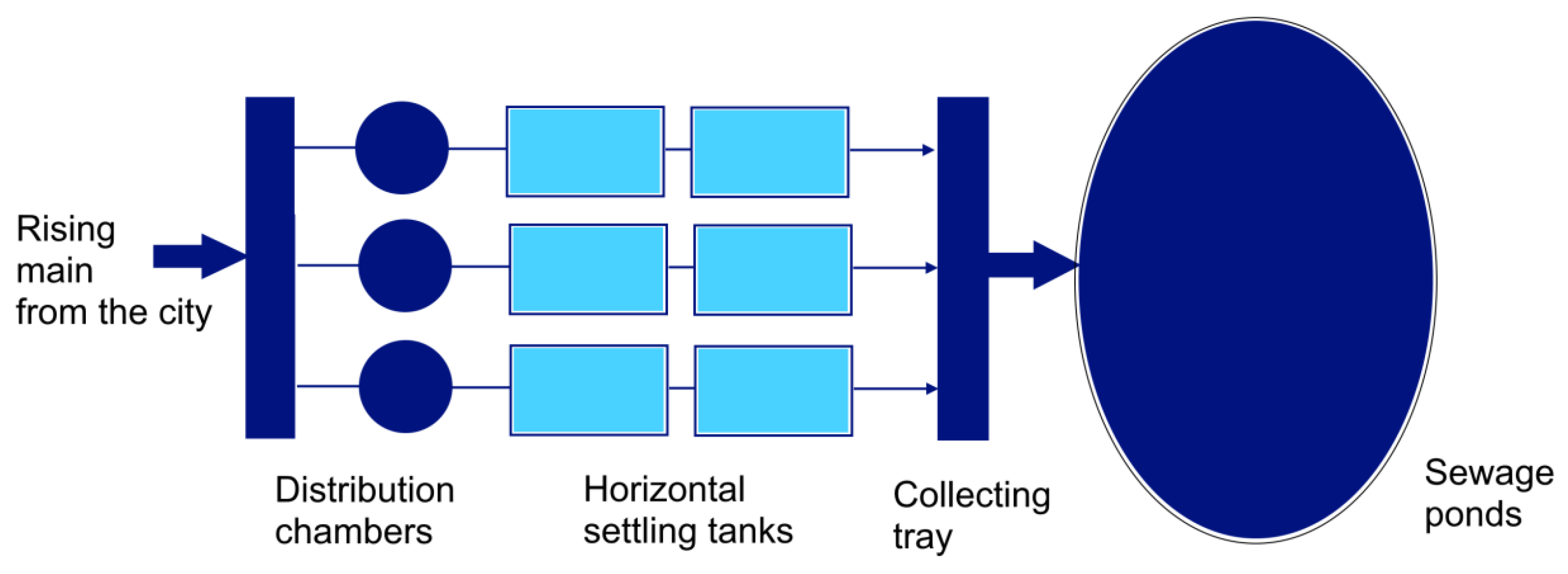
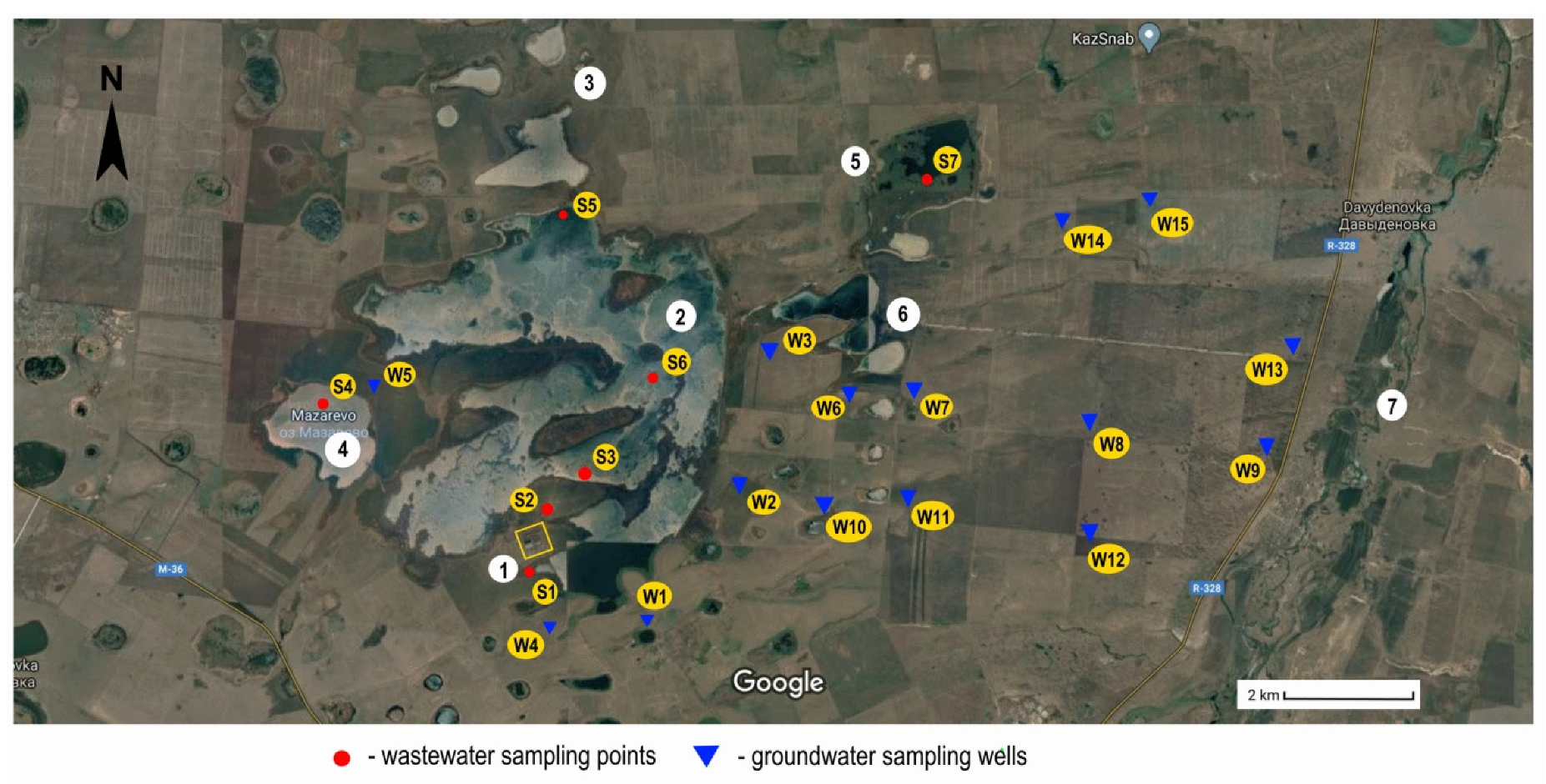
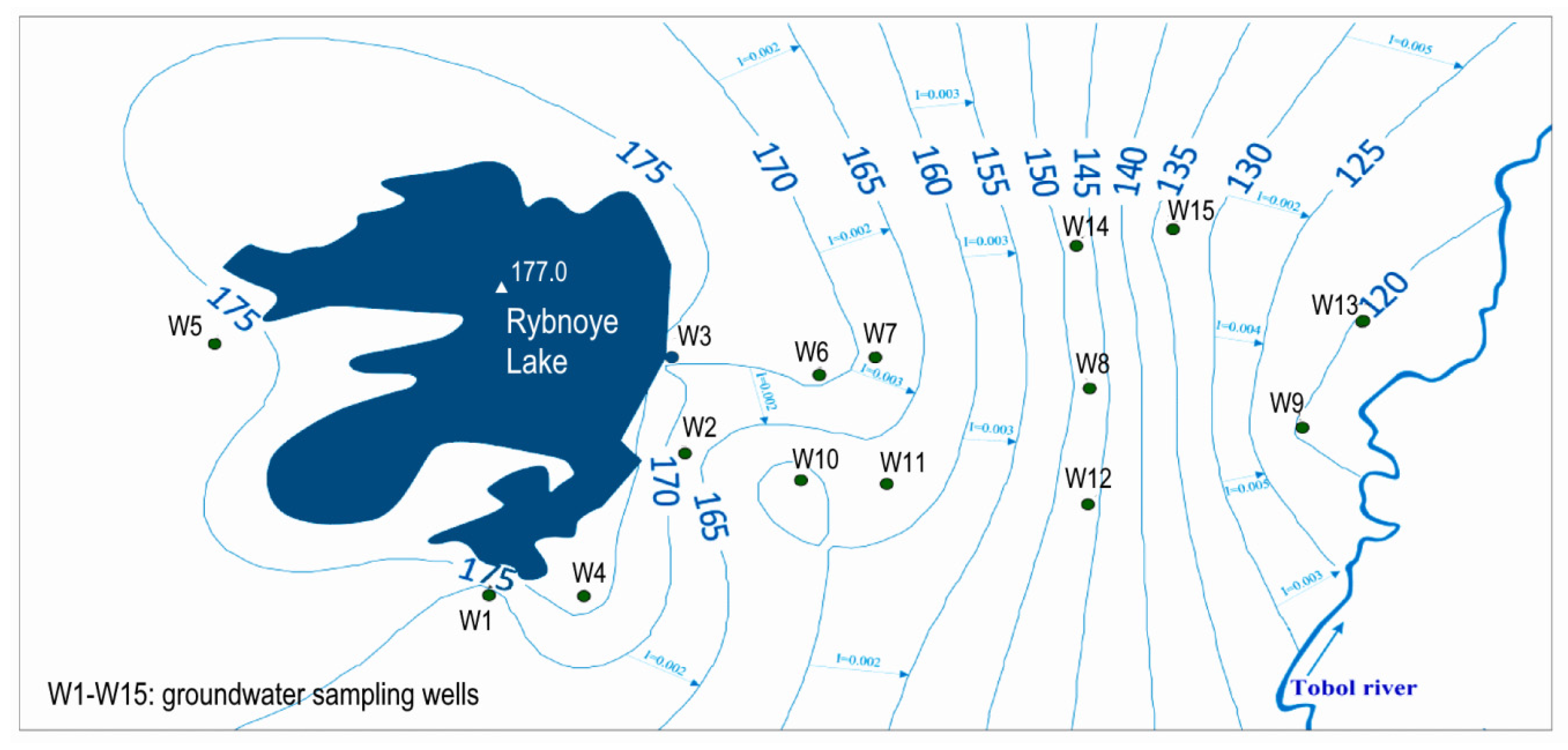
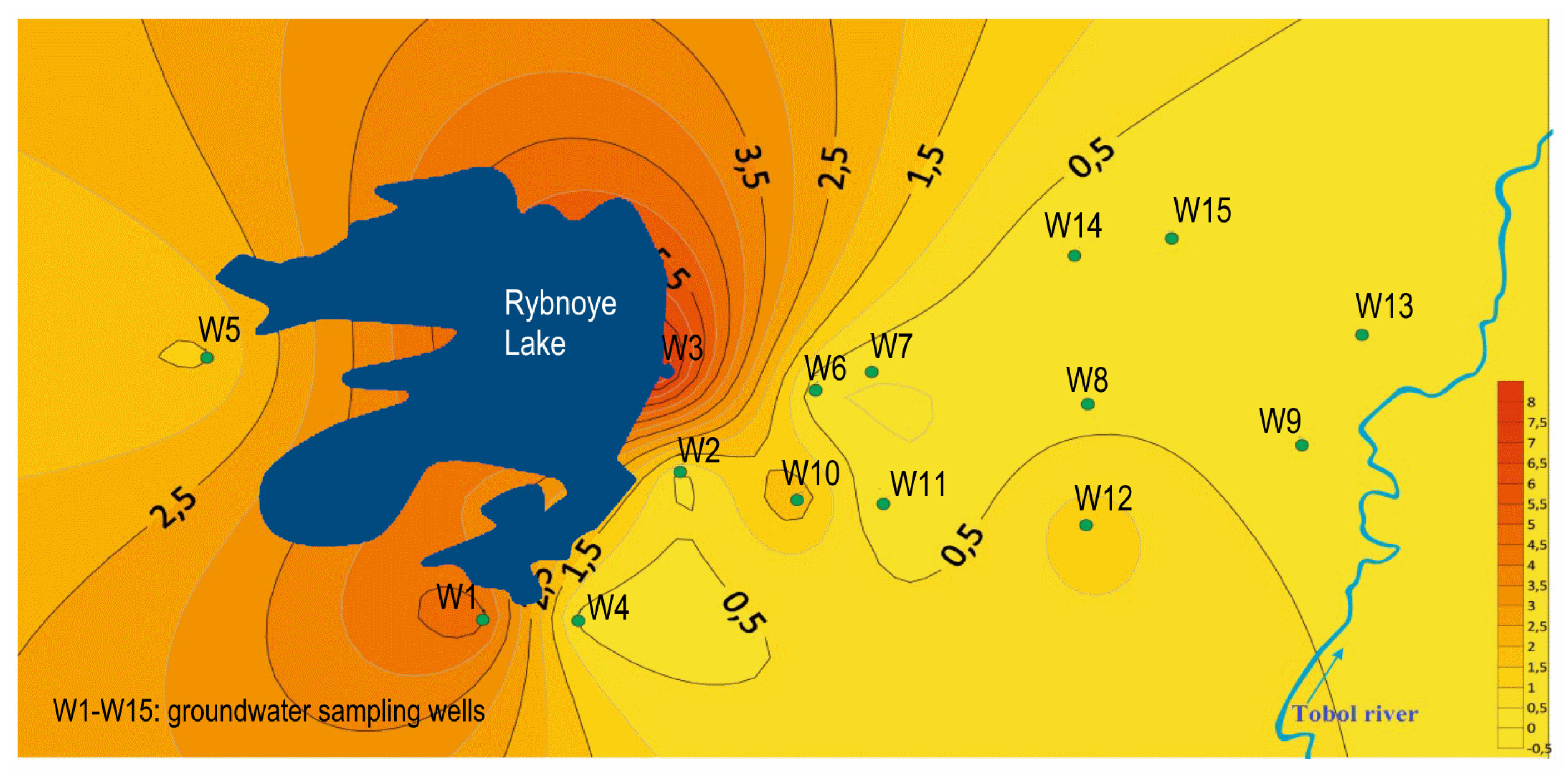
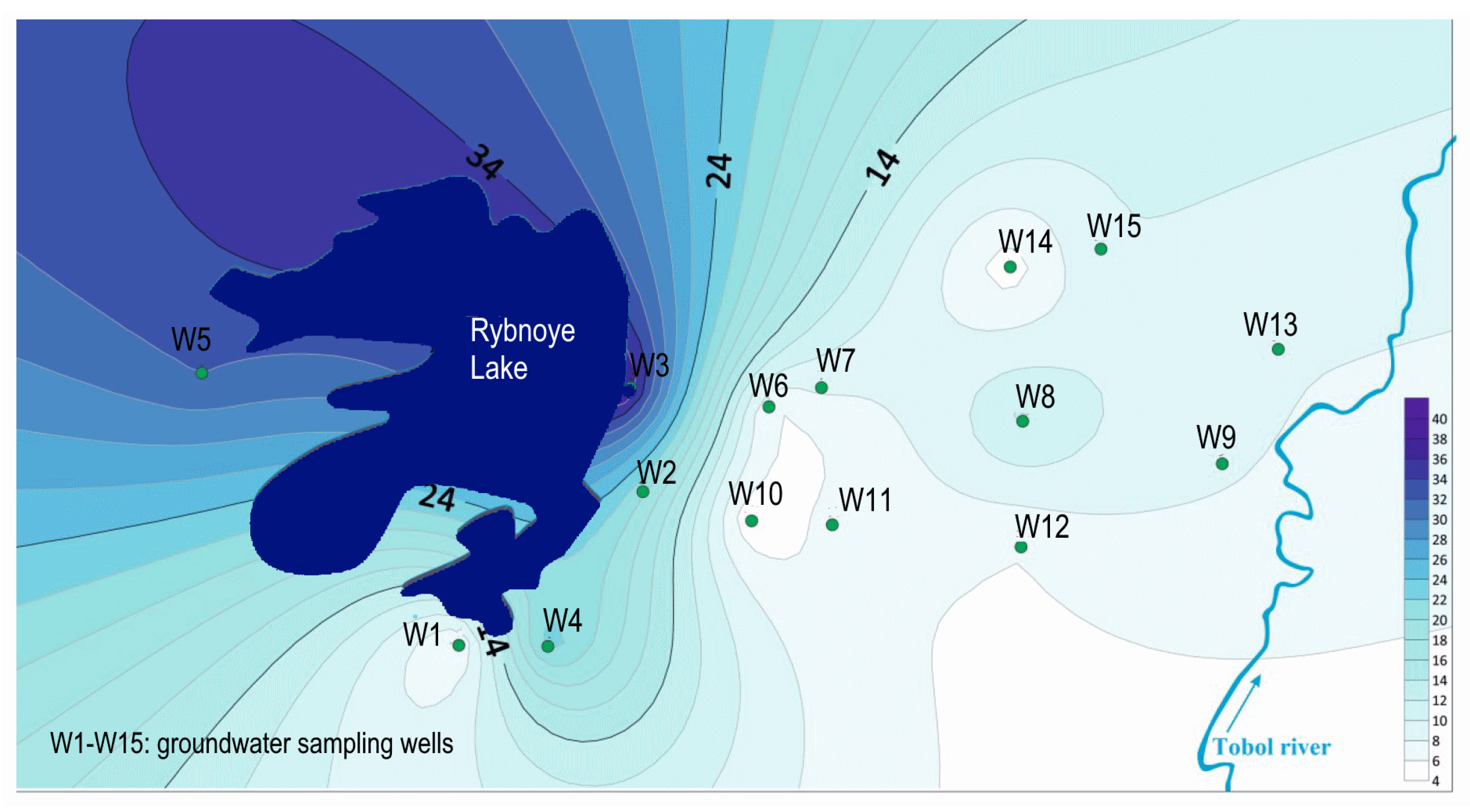
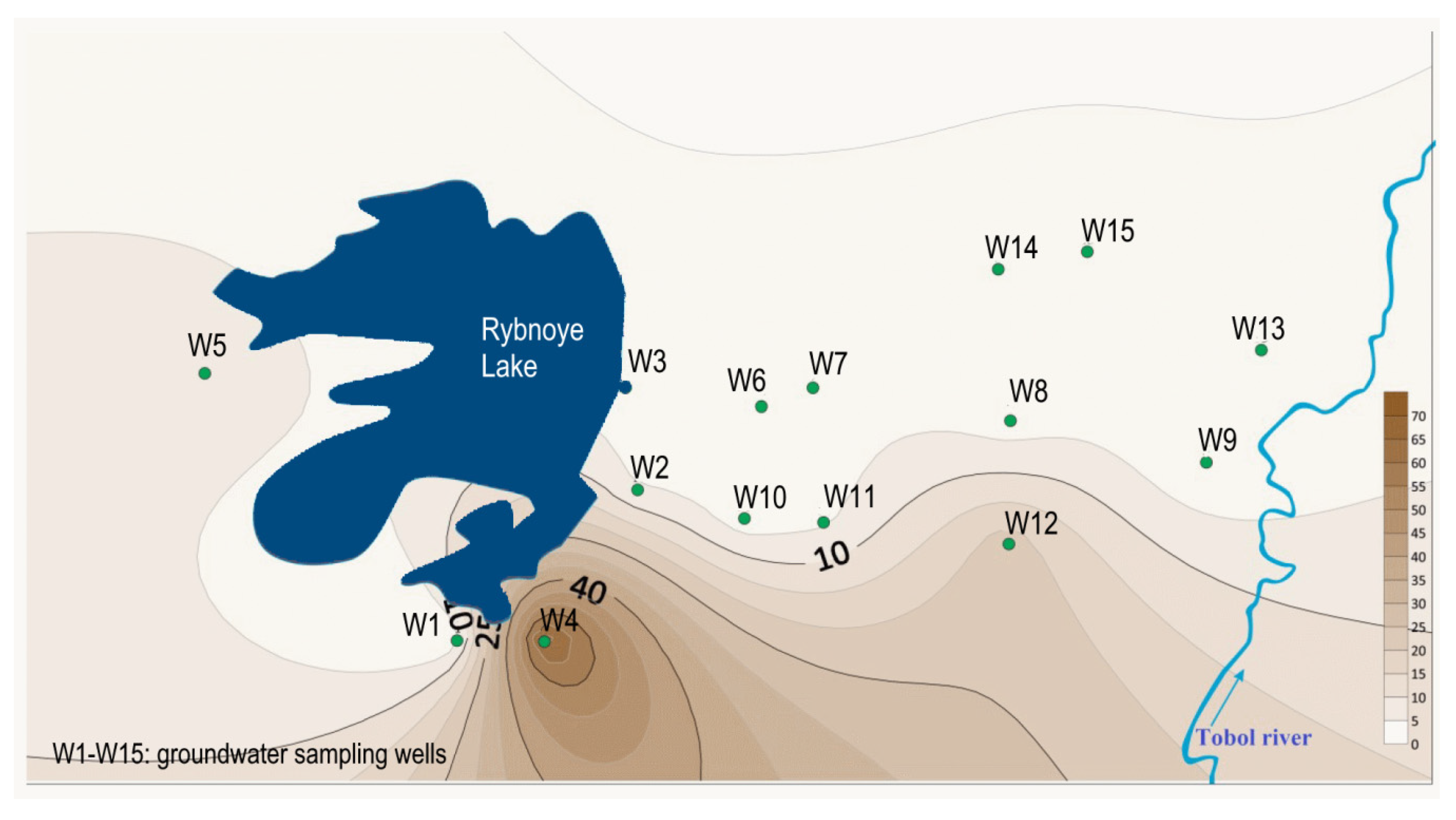
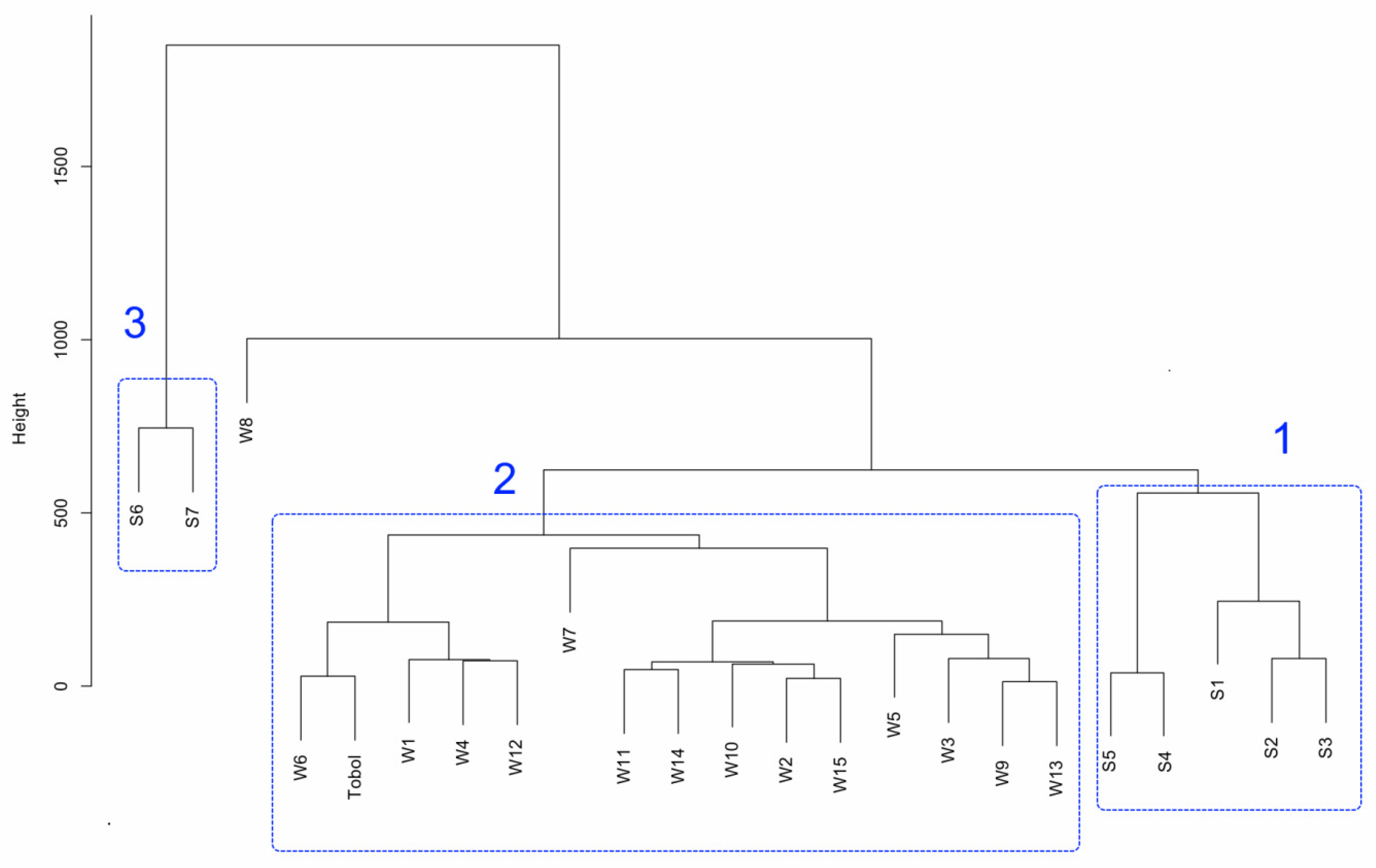
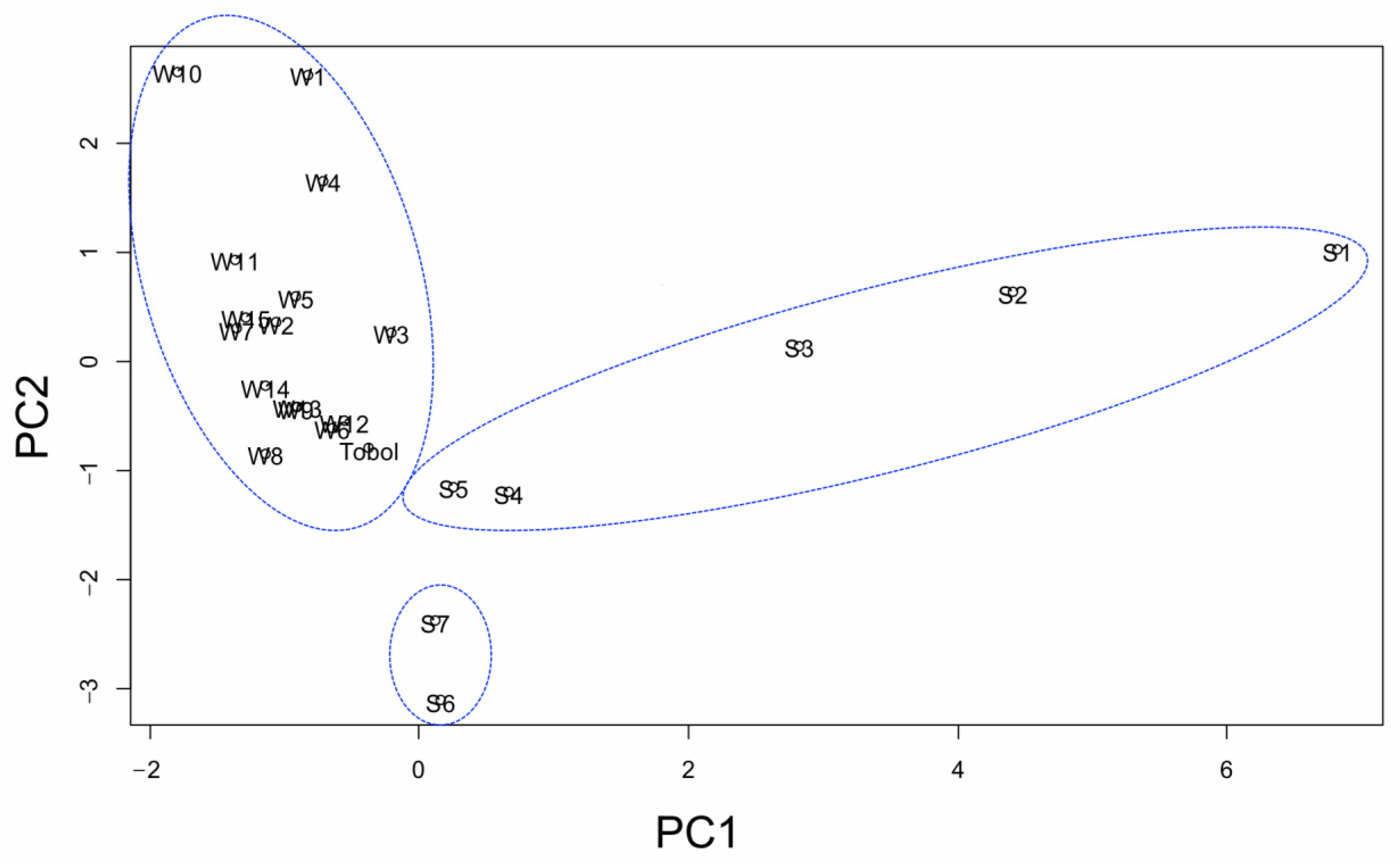
| Name of the Pond | Nominal Fill Height | Area | Nominal Capacity | Length of the Coastline |
|---|---|---|---|---|
| m a.s.l. | 106 m2 | 106 m3 | 103 m | |
| Rybnoye Lake (main storage) | 183.8 | 40.5 | 88.0 | 61.25 |
| Kurgan Lake | 183.7 | 8.19 | 11.73 | 15.75 |
| Mazarevo Lake | 175.7 | 4.5 | 6.1 | 13.0 |
| Popov Lake | 175.0 | 5.1 | 5.8 | 12.0 |
| Kolesnikov and Tomarkol Lake | 177.5 | 3.1 | 9.0 | 12.75 |
| Parameter | Unit | Sampling Points | MAC1 | MAC2 | ||||||
|---|---|---|---|---|---|---|---|---|---|---|
| S1 | S2 | S3 | S4 | S5 | S6 | S7 | ||||
| BOD5 | mg/dm3 | 282.5 | 231.3 | 190.7 | 49.5 | 40.7 | 20.4 | 18.0 | 87.02 | 3.0 |
| COD | mg/dm3 | 470.0 | 310.0 | 275.0 | 54.3 | 45.5 | 38.5 | 30.0 | 148.29 | 15.0 |
| TSS | mg/dm3 | 199.5 | 54.6 | 43.5 | 66.5 | 31.0 | 26.0 | 31.5 | 166.73 | 10.0 |
| N-NH4 | mg/dm3 | 76.56 | 84.9 | 31.87 | 1.16 | 0.64 | 2.14 | 0.86 | 31.45 | 0.5 |
| N-NO2 | mg/dm3 | 0.03 | 0.025 | 0.14 | 0.38 | 0.03 | 0.006 | 0.02 | 1.11 | - |
| N-NO3 | mg/dm3 | 0.83 | 0.54 | 1.04 | 1.03 | 0.59 | 0.39 | 0.86 | 6.92 | 40.0 |
| Phosphates | mg/dm3 | 8.7 | 6.5 | 5.93 | 4.2 | 3.28 | 0.72 | 0.46 | 5.95 | - |
| pH | -- | 6.85 | 7.2 | 7.45 | 8.85 | 8.45 | 8.65 | 8.8 | - | - |
| Cuprum | mg/dm3 | 0.01 | 0.01 | 0.004 | 0 | 0 | 0 | 0 | - | - |
| Potassium | mg/dm3 | 3.2 | 4 | 3.2 | 4.1 | 4.3 | 4.1 | 3.2 | - | - |
| Magnesium | mg/dm3 | 4.8 | 3 | 4.8 | 6.2 | 6.7 | 12.2 | 10.2 | - | - |
| Chlorides | mg/dm3 | 267.3 | 272.3 | 262.4 | 678.2 | 673.2 | 2425.5 | 1683 | 350.0 | 300.0 |
| Sulfates | mg/dm3 | 109.5 | 104.9 | 91.3 | 91.3 | 100.4 | 123.2 | 82.1 | 187.4 | 100.0 |
| Hardness | mg/dm3 | 8 | 7 | 8 | 10.3 | 11 | 16.3 | 13.4 | - | - |
| Iron | mg/dm3 | 0.63 | 0.87 | 0.82 | 0.34 | 0.19 | 0.18 | 0.15 | 0.76 | 0.1 |
| Manganese | mg/dm3 | 0.22 | 0.2 | 0.2 | 0.03 | 0.22 | 0.01 | 0.05 | 0.37 | 0.01 |
| Oil products | mg/dm3 | 0 | 0 | 0 | 0 | 0 | 0 | 0 | 0.3 | 0.05 |
| Surfactants | mg/dm3 | 0.2 | 2.2 | 1.85 | 0.07 | 0.12 | 0.14 | 0.11 | 0.91 | - |
| Dry residue | mg/dm3 | 1044.5 | 969 | 972.5 | 1607 | 1707 | 4271.5 | 3191 | - | - |
| Parameter | Removal Efficiency in Sampling Points | |||||
|---|---|---|---|---|---|---|
| S2 | S3 | S4 | S5 | S6 | S7 | |
| % | ||||||
| BOD5 | 18.12 | 32.50 | 82.48 | 85.59 | 92.78 | 93.63 |
| COD | 34.04 | 41.49 | 88.45 | 90.32 | 91.81 | 93.62 |
| TSS | 72.63 | 78.20 | 66.67 | 84.46 | 86.97 | 84.21 |
| Sampling Point | TSS | BOD5 | COD | SO4− | Cl− | Fe | N-NH4 | N-NO3 | Mn |
|---|---|---|---|---|---|---|---|---|---|
| (mg/dm3) | |||||||||
| Groundwater | |||||||||
| W1 | 40.5 | 5.4 | 7 | 102.5 | 25 | 2.9 | 4.84 | 1.11 | 2.7 |
| W2 | 11.5 | 20.5 | 27 | 650 | 117.5 | 0.36 | 0.35 | 5.03 | 0.8 |
| W3 | 27.5 | 39.5 | 52.8 | 400 | 125 | 0.43 | 7.9 | 2.99 | 0.78 |
| W4 | 27 | 23.14 | 30.7 | 96.3 | 47.5 | 0.38 | 0.3 | 67.89 | 1.64 |
| W5 | 7.35 | 32.05 | 42.2 | 545 | 216.8 | 0.72 | 1.4 | 7.28 | 1.05 |
| W6 | 6.4 | 5.98 | 7.68 | 215 | 185 | 0.9 | 0.05 | 3.77 | 0.005 |
| W7 | 5.8 | 8.51 | 11.5 | 672.5 | 480 | 0.87 | 0.07 | 3.77 | 0.98 |
| W8 | 4.6 | 12.5 | 16.3 | 685 | 1100 | 1.68 | 0.3 | 1.99 | 0.028 |
| W9 | 4.4 | 8.38 | 10.6 | 456.3 | 125 | 0.5 | 0.05 | 0.11 | 0.17 |
| W10 | 5.4 | 4.26 | 5.76 | 655 | 55 | 6.1 | 2 | 1.44 | 0.99 |
| W11 | 5.2 | 6.9 | 8.64 | 570 | 60 | 1.36 | 0.04 | 3.77 | 1.12 |
| W12 | 4.6 | 6.12 | 7.68 | 102.5 | 90 | 0.31 | 1.3 | 22.6 | 0.02 |
| W13 | 4.3 | 8.25 | 10.6 | 450 | 115 | 0.45 | 0.05 | 1.44 | 0.17 |
| W14 | 5.3 | 4.79 | 6.72 | 610 | 85 | 0.45 | 0.05 | 1.44 | 0.22 |
| W15 | 3.6 | 9.84 | 13.4 | 640 | 112.5 | 0.44 | 0.05 | 1.77 | 0.93 |
| Tobol river | |||||||||
| Tobol R. | 29.5 | 3.4 | 3.8 | 230.0 | 180.7 | 0.3 | 0.56 | 0.4 | 0.04 |
| MAC2 | 10.0 | 3.0 | 15.0 | 100.0 | 300.0 | 0.1 | 0.5 | 40.0 | 0.01 |
| PC1 | PC2 | PC3 | PC4 | PC5 | PC6 | PC7 | PC8 | PC9 | |
|---|---|---|---|---|---|---|---|---|---|
| Standard deviation | 1.9936 | 0.3226 | 0.1538 | 0.9031 | 0.6495 | 0.6365 | 0.4959 | 0.2324 | 0.0507 |
| Proportion of Variance | 0.4416 | 0.1944 | 0.1479 | 0.0906 | 0.0469 | 0.0450 | 0.0273 | 0.0060 | 0.0003 |
| Cumulative Proportion | 0.4416 | 0.6360 | 0.7839 | 0.8745 | 0.9214 | 0.9664 | 0.9937 | 0.9997 | 1.0000 |
| Primary Components and Variables | ||||||||||||
|---|---|---|---|---|---|---|---|---|---|---|---|---|
| PC1 | PC2 | PC3 | TSS | BOD | COD | N-NH4 | N-NO3 | Fe | Mn | SO4 | Cl | |
| PC1 | 1.00 | |||||||||||
| PC2 | 0.00 | 1.00 | ||||||||||
| PC3 | 0.00 | 0.00 | 1.00 | |||||||||
| TSS | 0.88 | 0.10 | 0.05 | 1.00 | ||||||||
| BOD | 0.97 | 0.15 | −0.07 | 0.80 | 1.00 | |||||||
| COD | 0.97 | 0.15 | −0.08 | 0.84 | 0.99 | 1.00 | ||||||
| N-NH4 | 0.93 | 0.21 | −0.12 | 0.74 | 0.95 | 0.94 | 1.00 | |||||
| N-NO3 | −0.13 | 0.26 | 0.87 | −0.08 | −0.12 | −0.12 | −0.14 | 1.00 | ||||
| Fe | −0.21 | 0.62 | −0.43 | −0.11 | −0.11 | −0.10 | −0.03 | −0.12 | 1.00 | |||
| Mn | −0.29 | 0.76 | 0.25 | −0.10 | −0.21 | −0.20 | −0.16 | 0.33 | 0.42 | 1.00 | ||
| SO4 | −0.56 | 0.25 | −0.55 | −0.50 | −0.42 | −0.40 | −0.37 | −0.21 | 0.29 | 0.15 | 1.00 | |
| Cl | 0.07 | −0.75 | −0.04 | 0.05 | −0.05 | −0.04 | −0.09 | −0.20 | −0.21 | −0.38 | −0.25 | 1.00 |
© 2020 by the authors. Licensee MDPI, Basel, Switzerland. This article is an open access article distributed under the terms and conditions of the Creative Commons Attribution (CC BY) license (http://creativecommons.org/licenses/by/4.0/).
Share and Cite
Ospanov, K.; Rakhimov, T.; Myrzakhmetov, M.; Andraka, D. Assessment of the Impact of Sewage Storage Ponds on the Water Environment in Surrounding Area. Water 2020, 12, 2483. https://doi.org/10.3390/w12092483
Ospanov K, Rakhimov T, Myrzakhmetov M, Andraka D. Assessment of the Impact of Sewage Storage Ponds on the Water Environment in Surrounding Area. Water. 2020; 12(9):2483. https://doi.org/10.3390/w12092483
Chicago/Turabian StyleOspanov, Kairat, Timur Rakhimov, Menlibai Myrzakhmetov, and Dariusz Andraka. 2020. "Assessment of the Impact of Sewage Storage Ponds on the Water Environment in Surrounding Area" Water 12, no. 9: 2483. https://doi.org/10.3390/w12092483
APA StyleOspanov, K., Rakhimov, T., Myrzakhmetov, M., & Andraka, D. (2020). Assessment of the Impact of Sewage Storage Ponds on the Water Environment in Surrounding Area. Water, 12(9), 2483. https://doi.org/10.3390/w12092483





